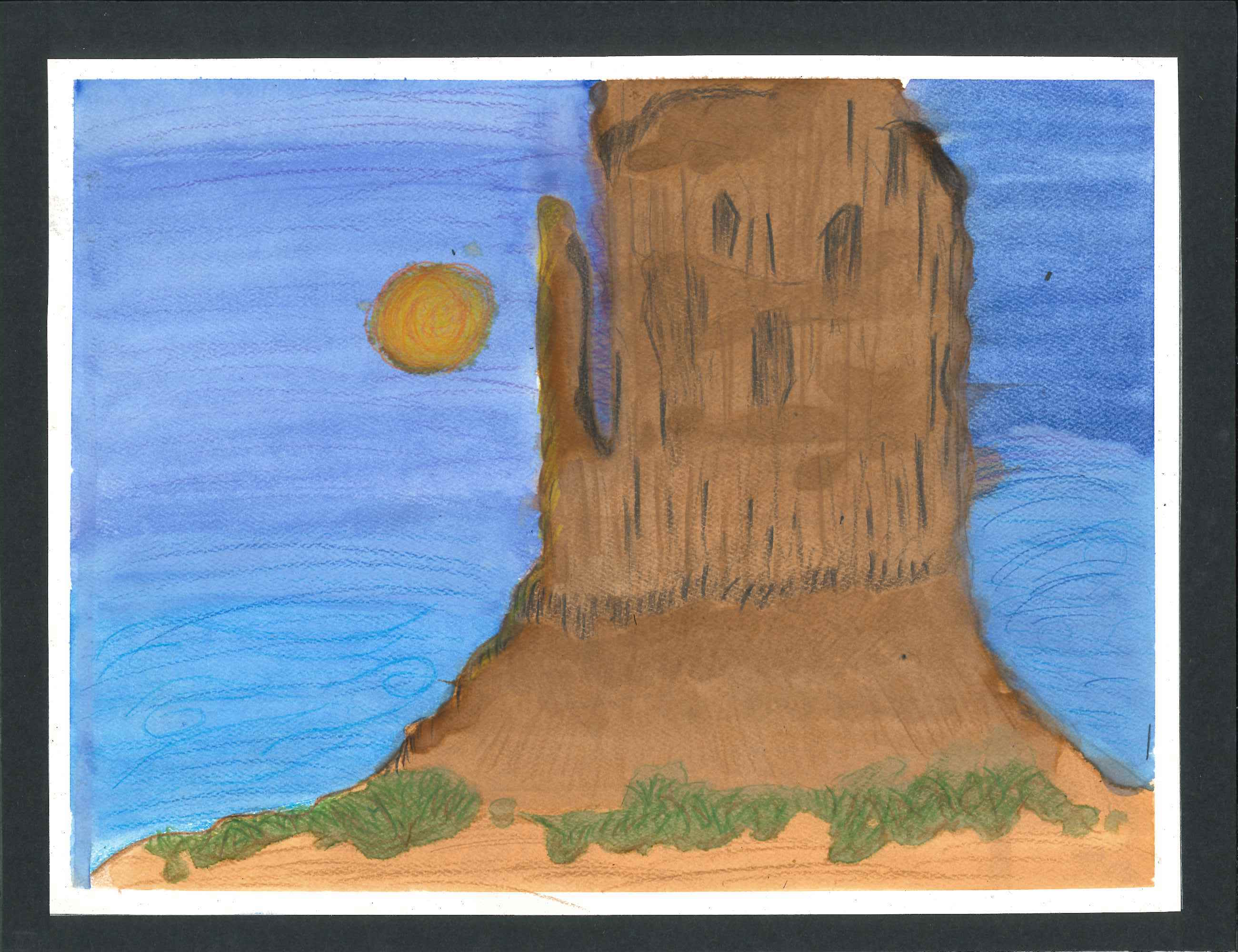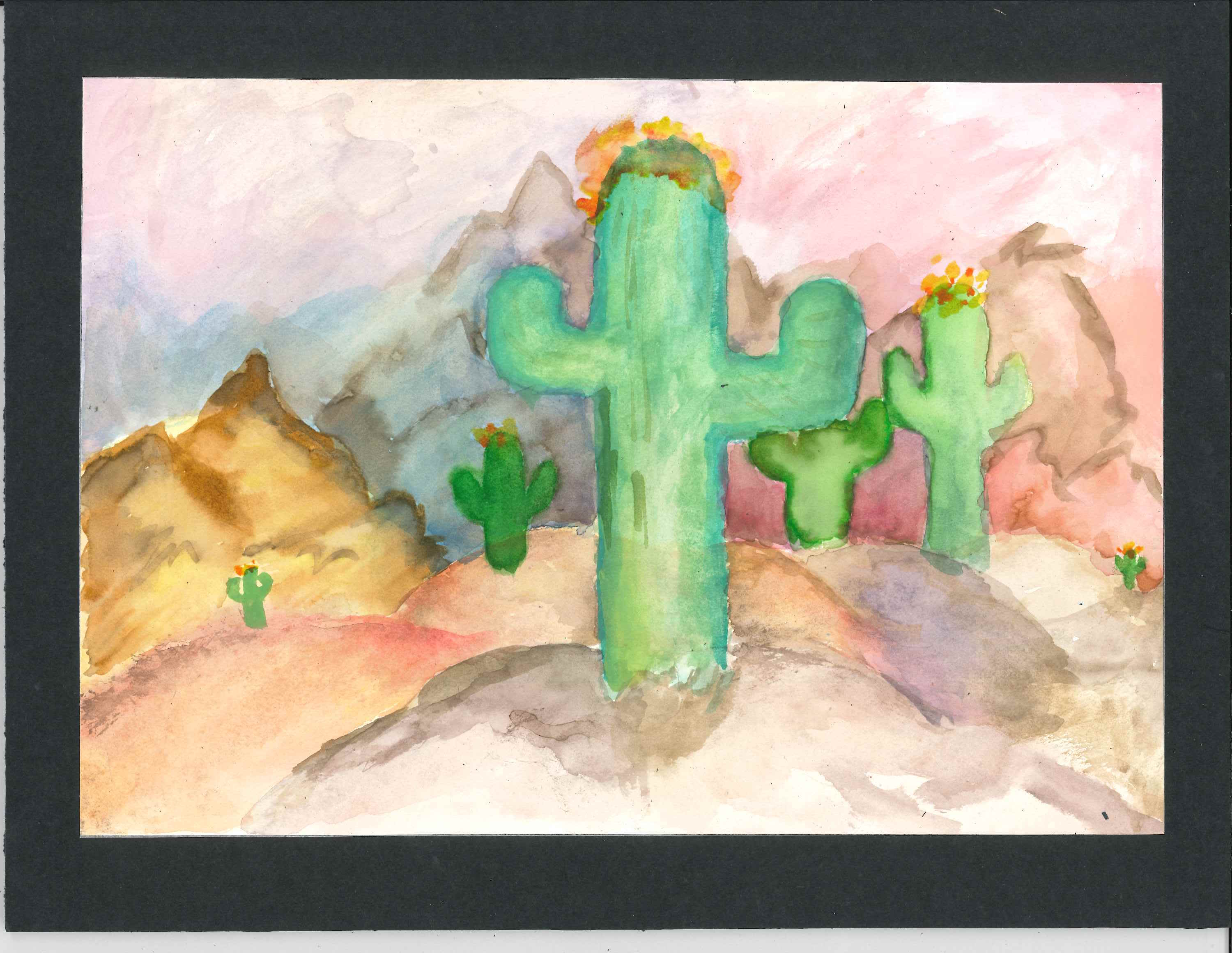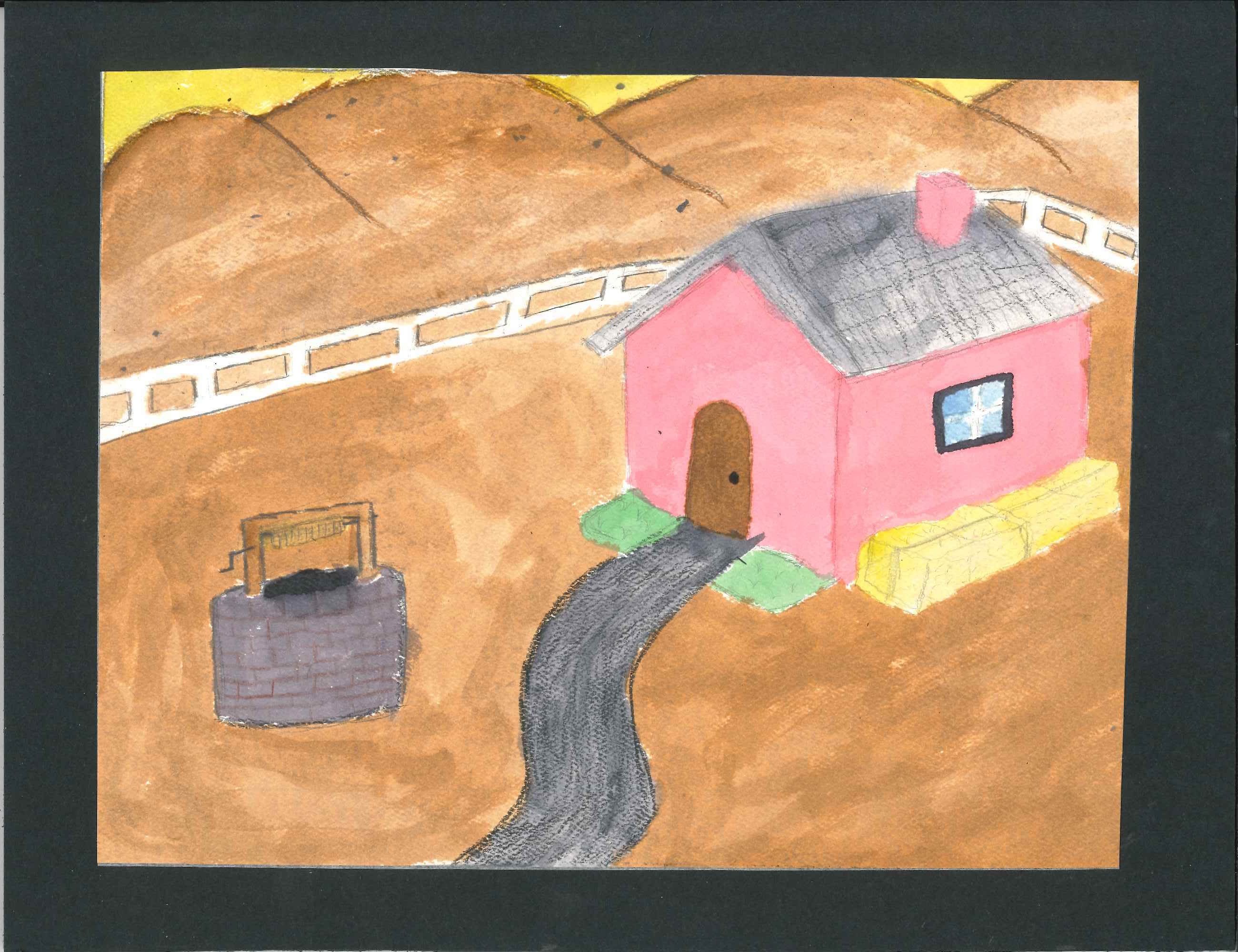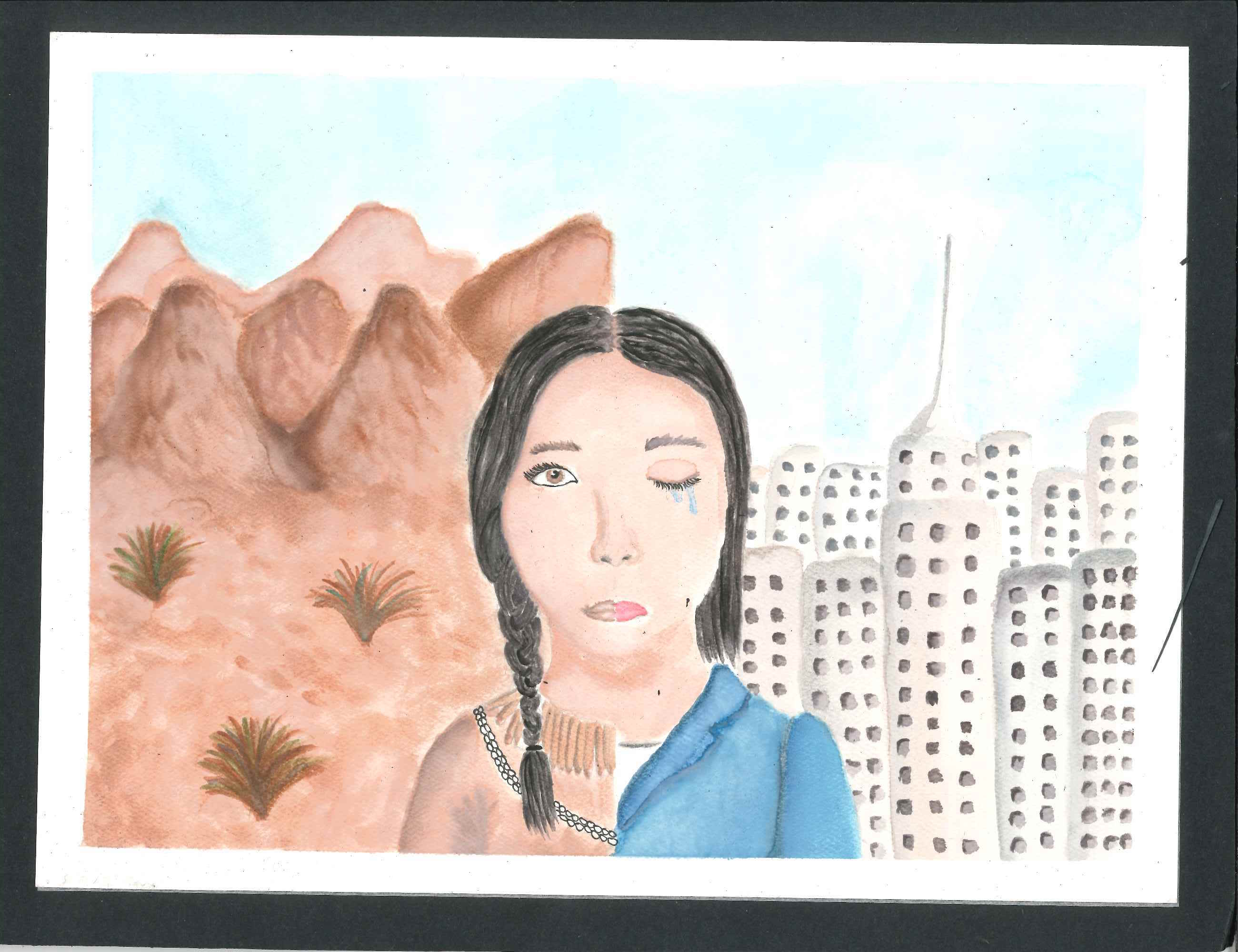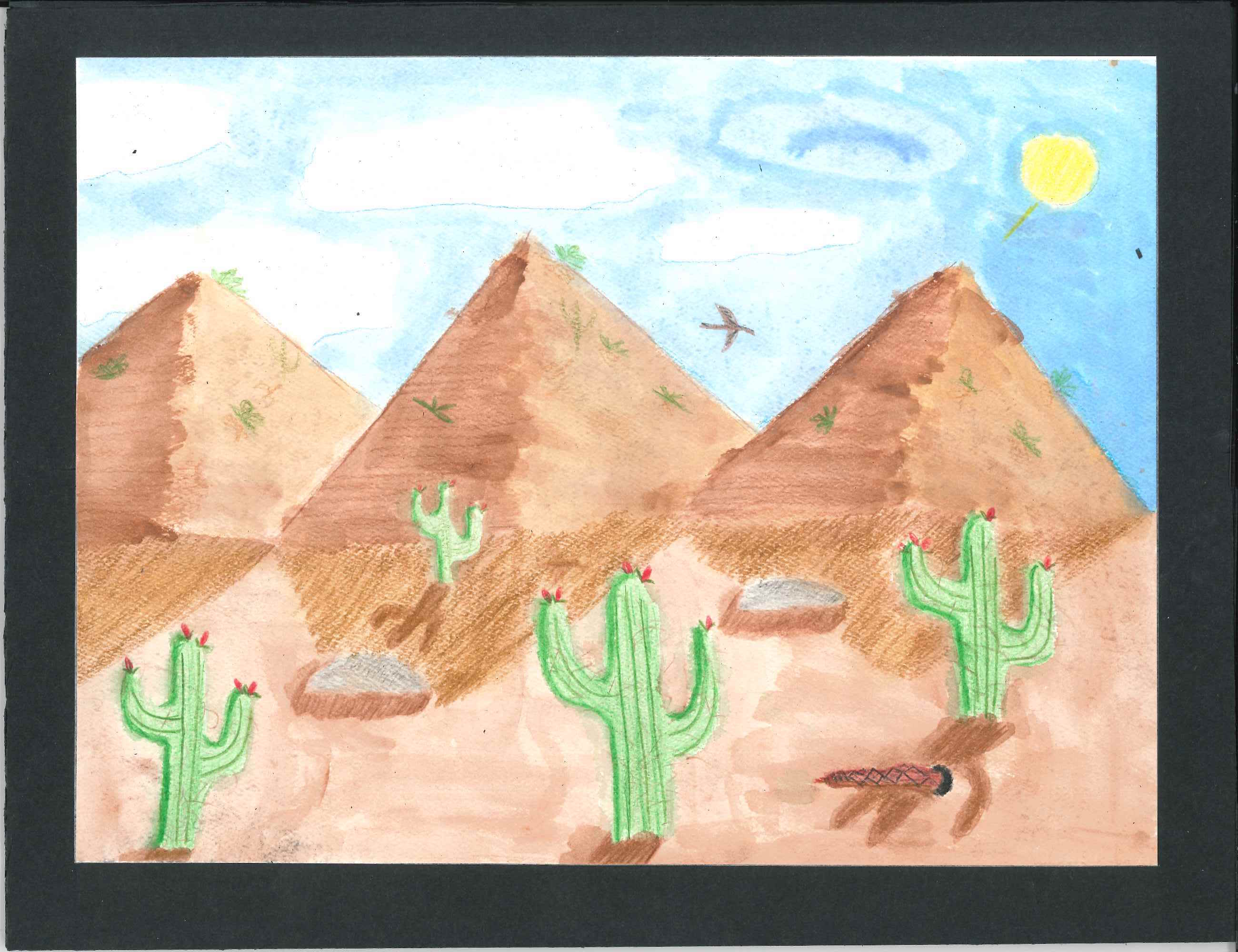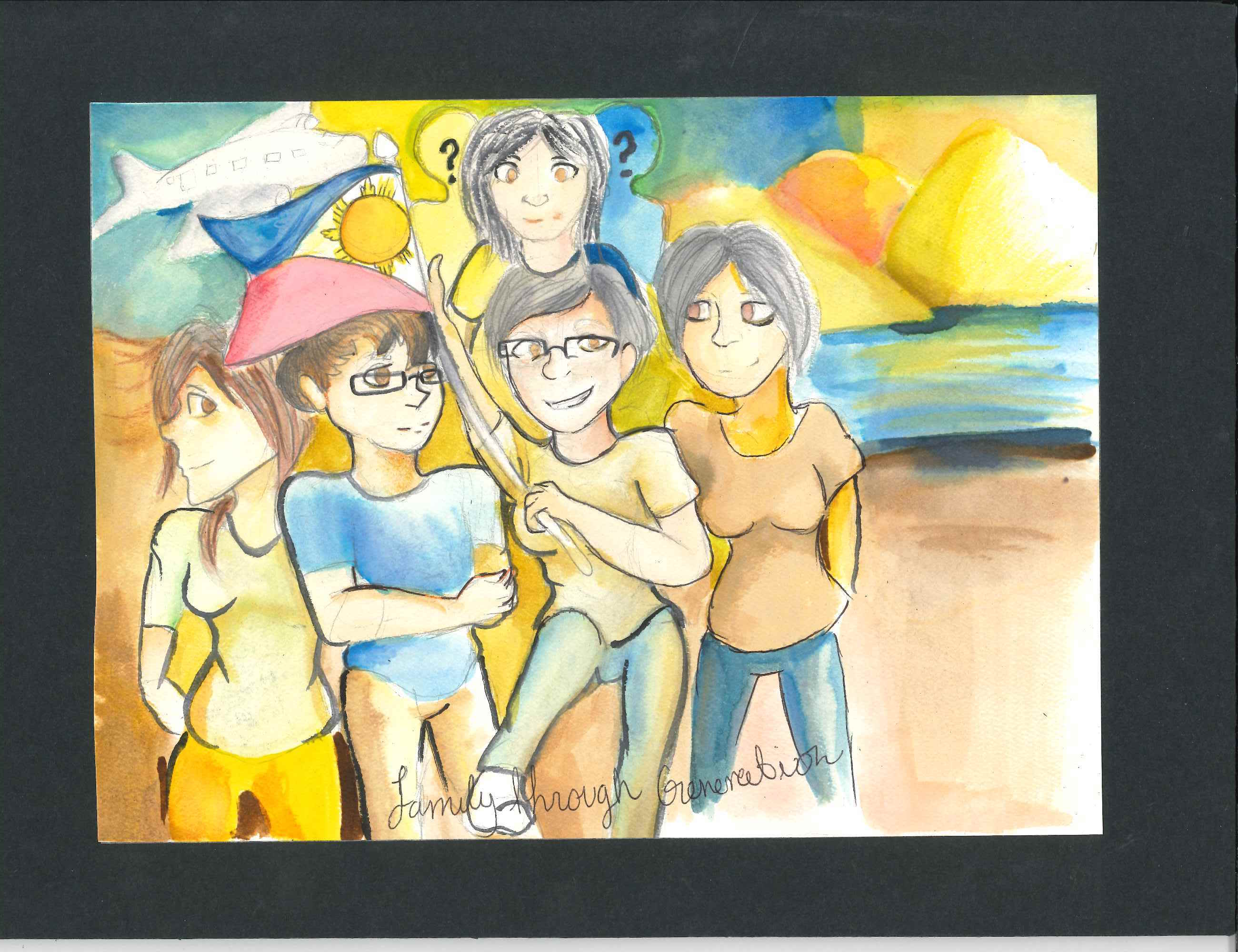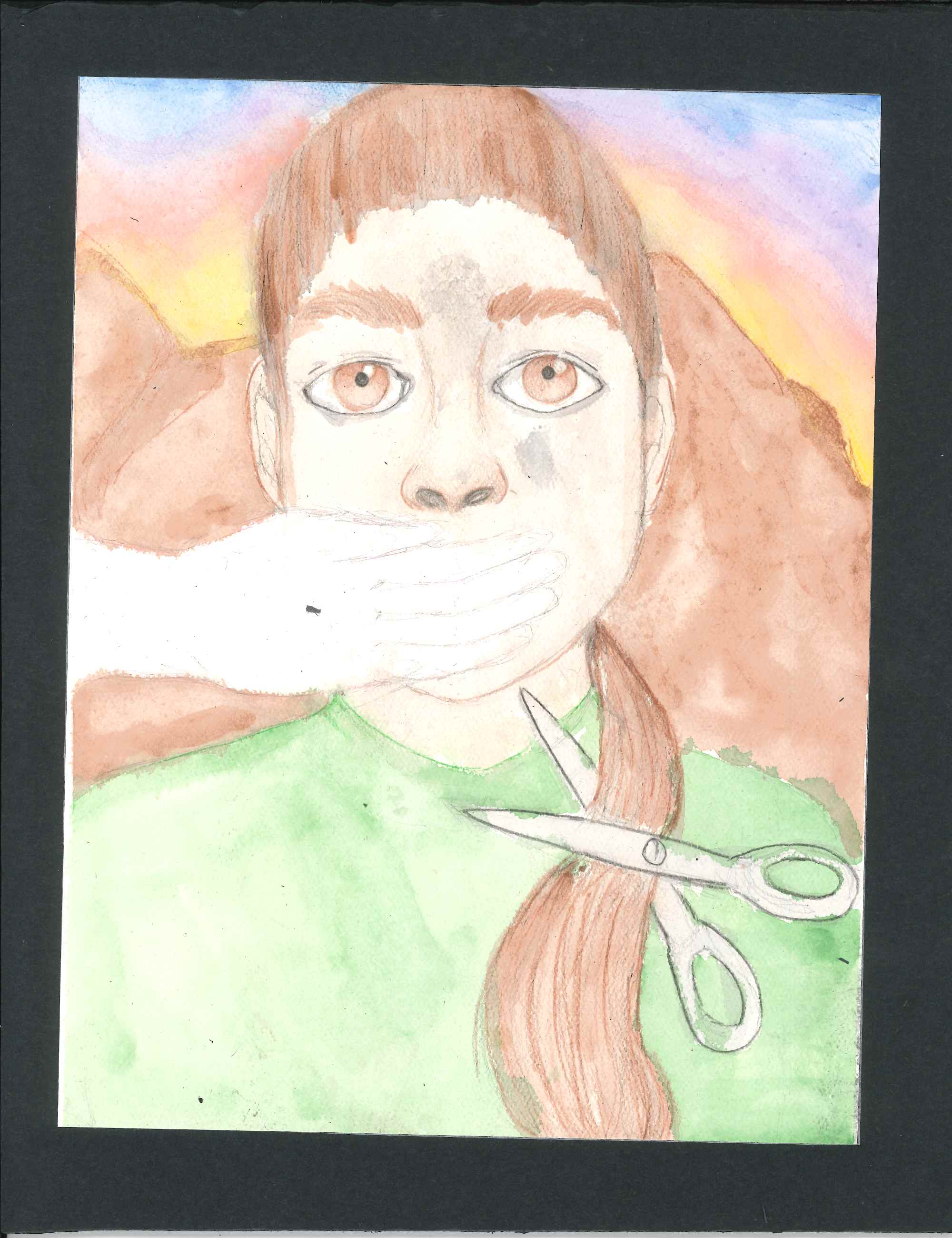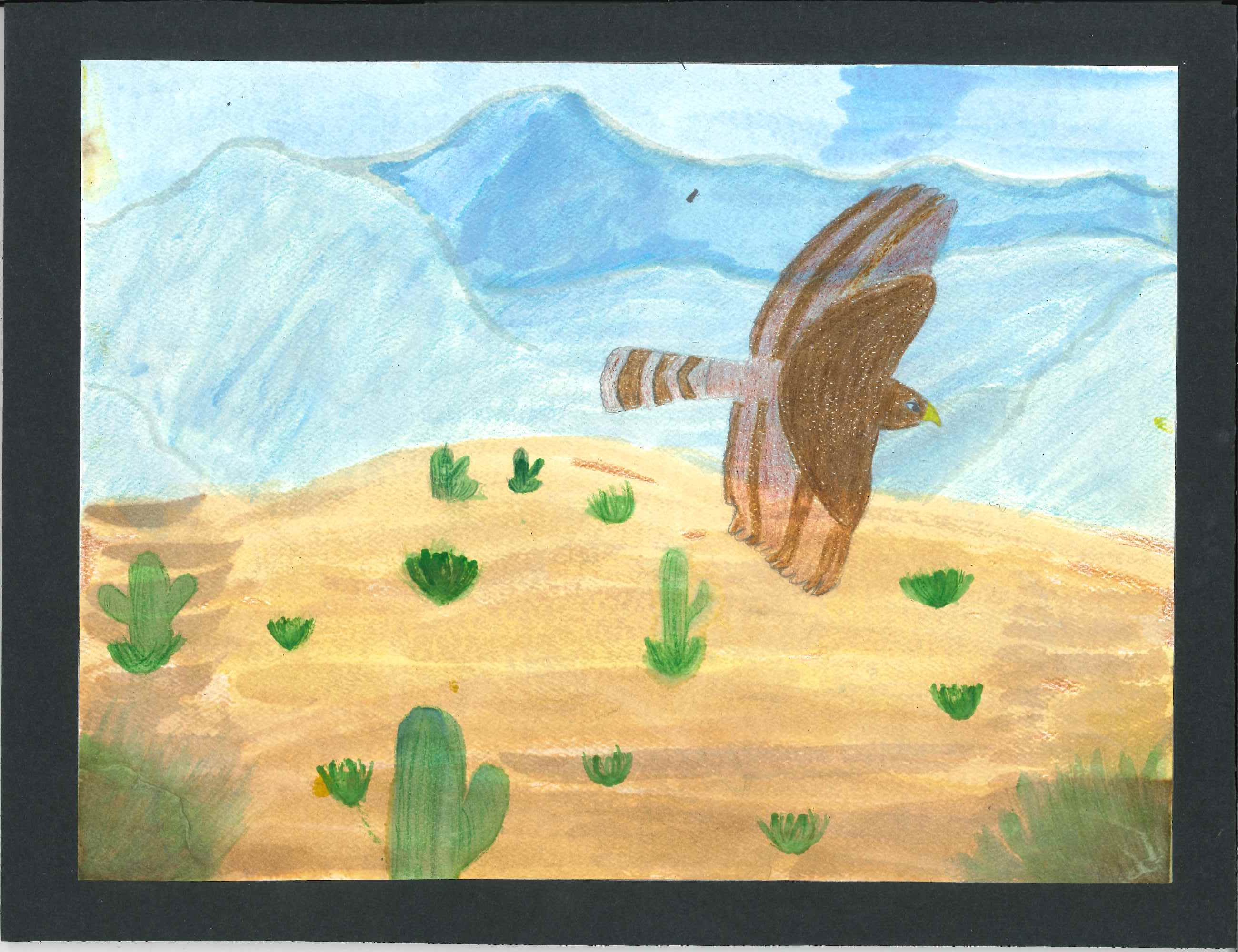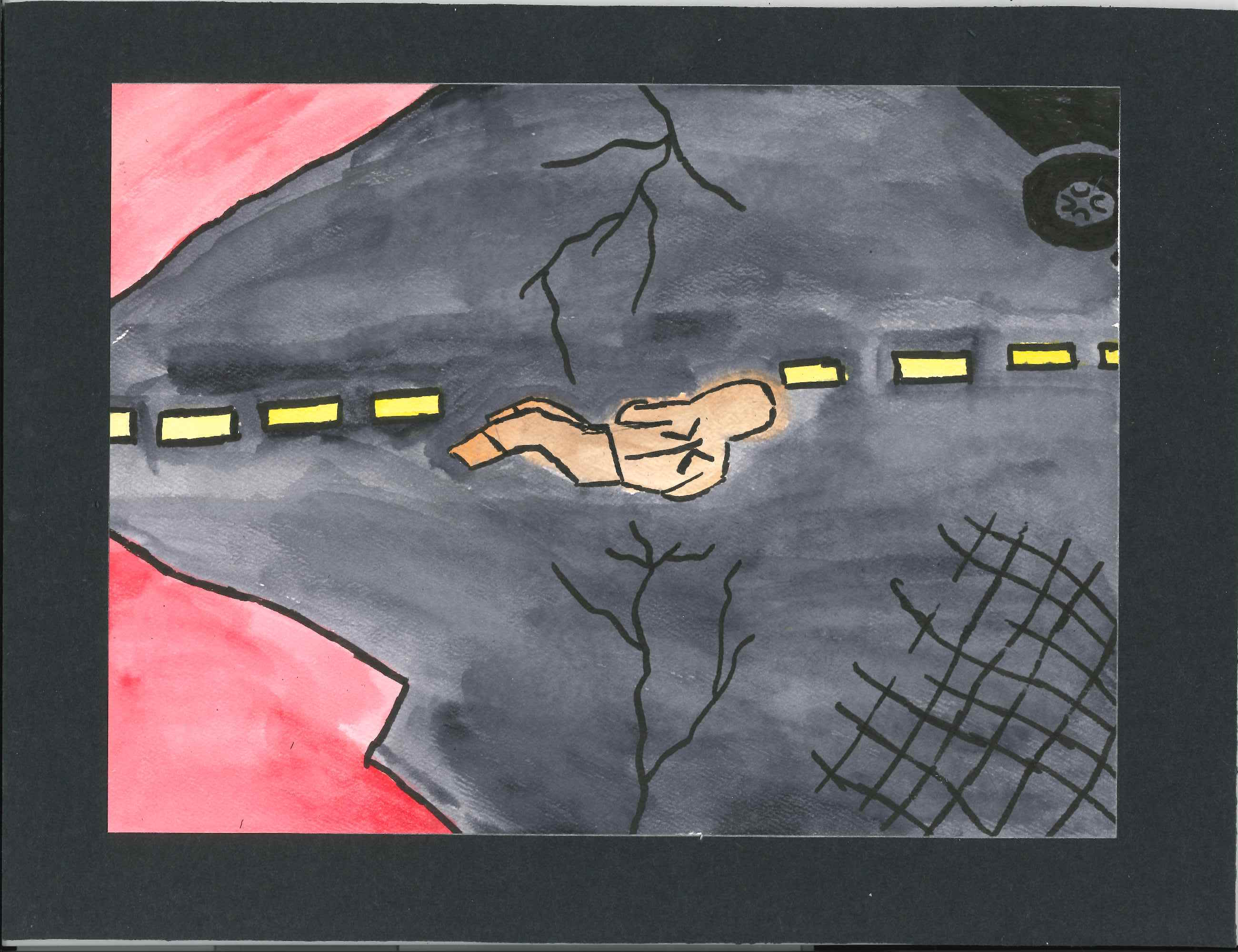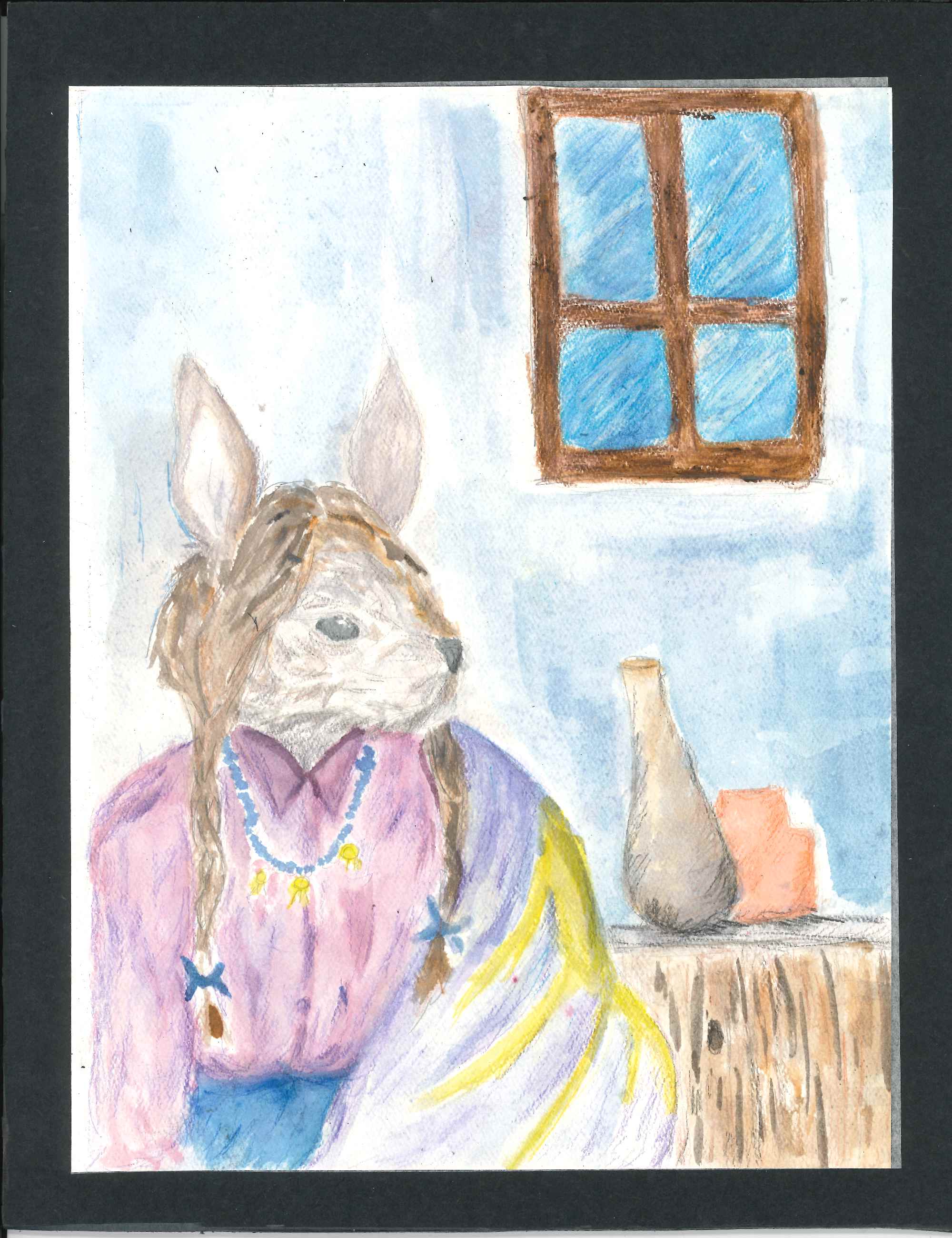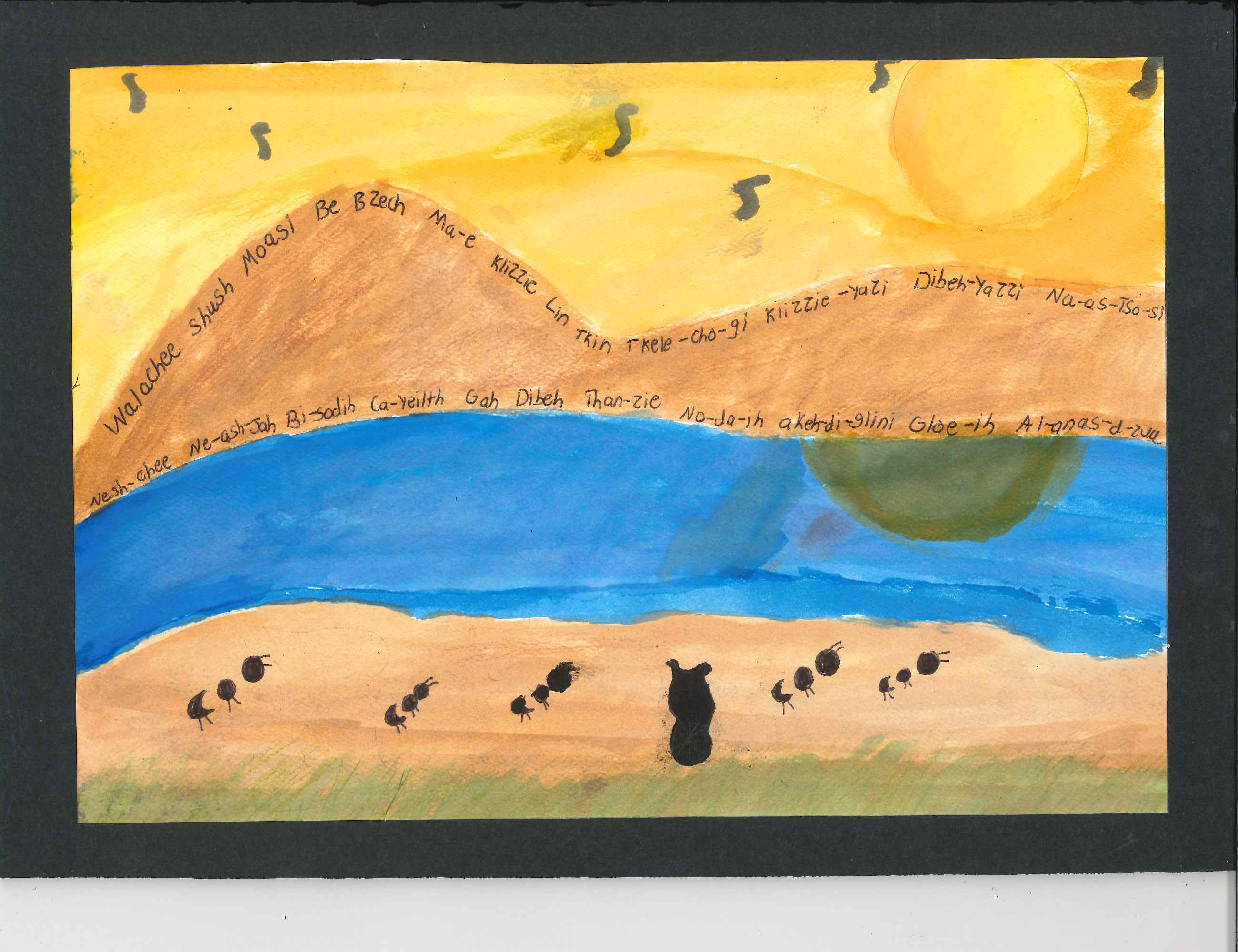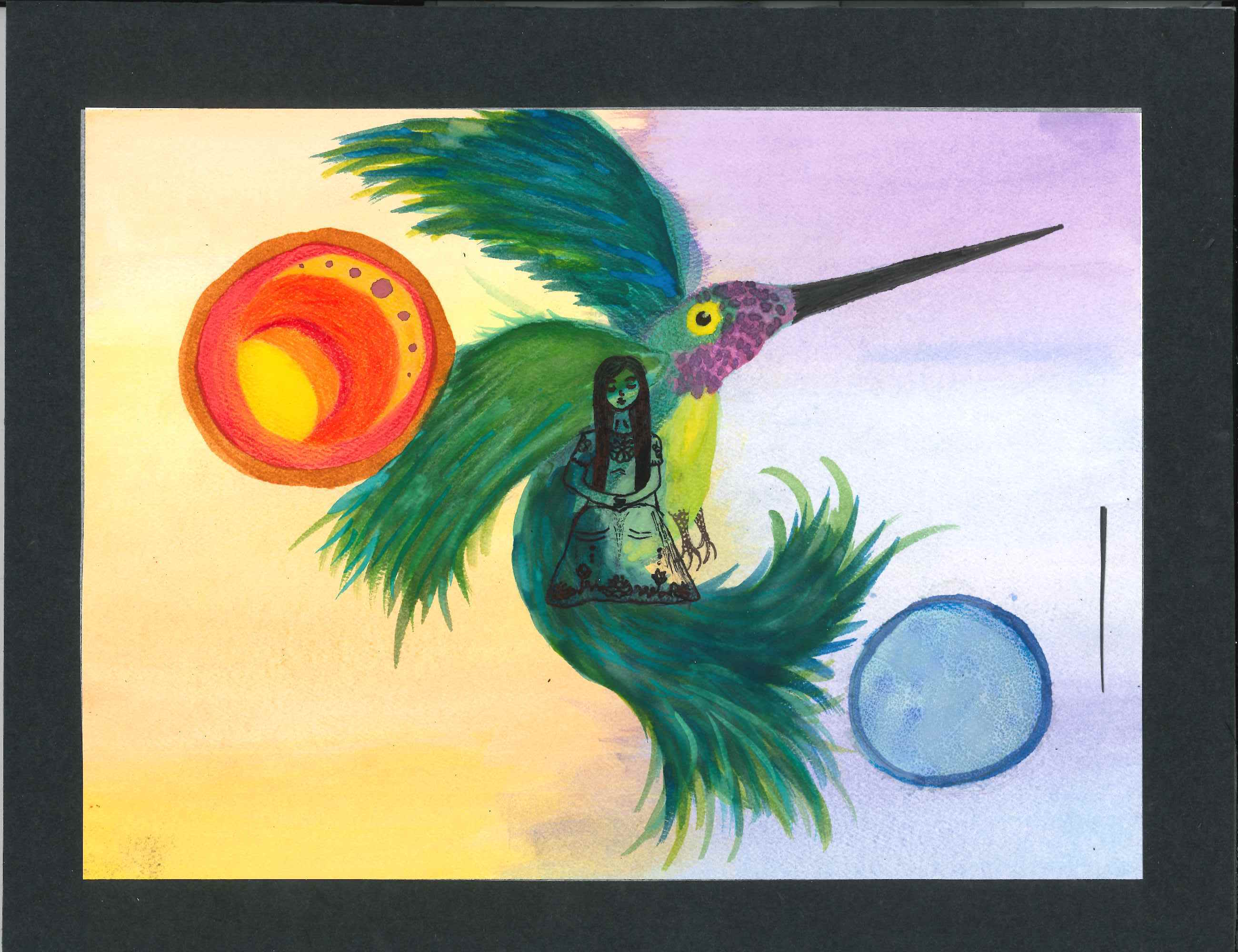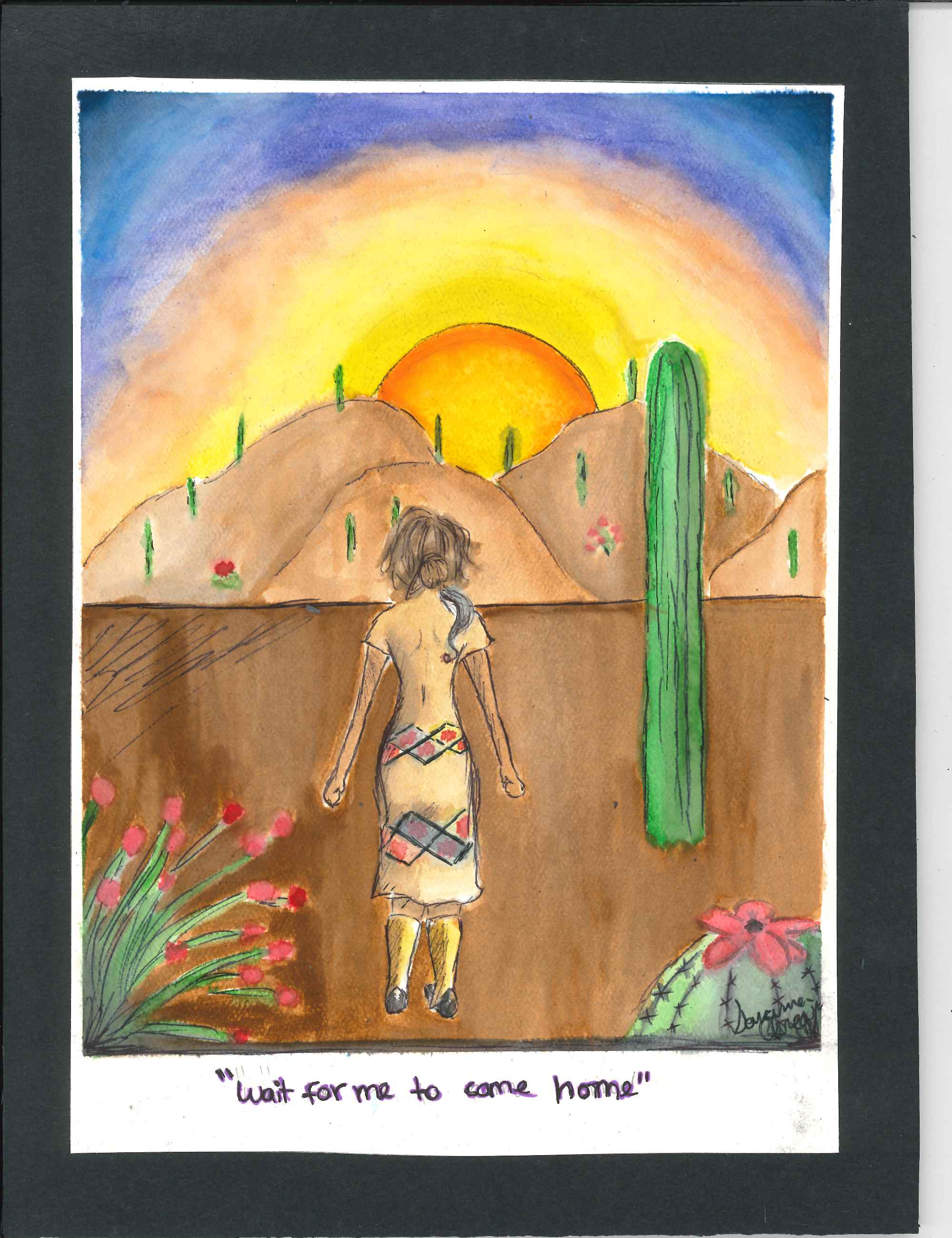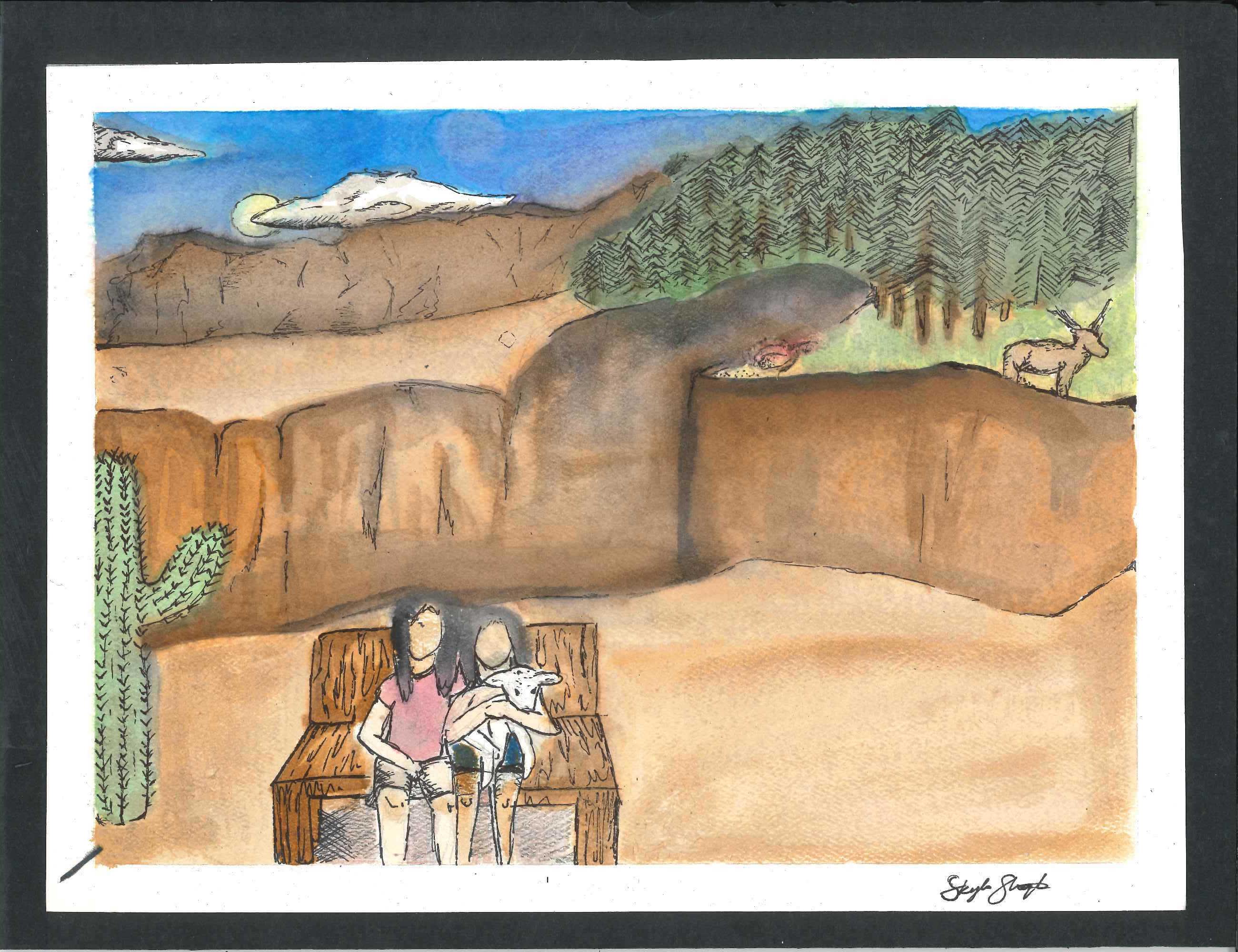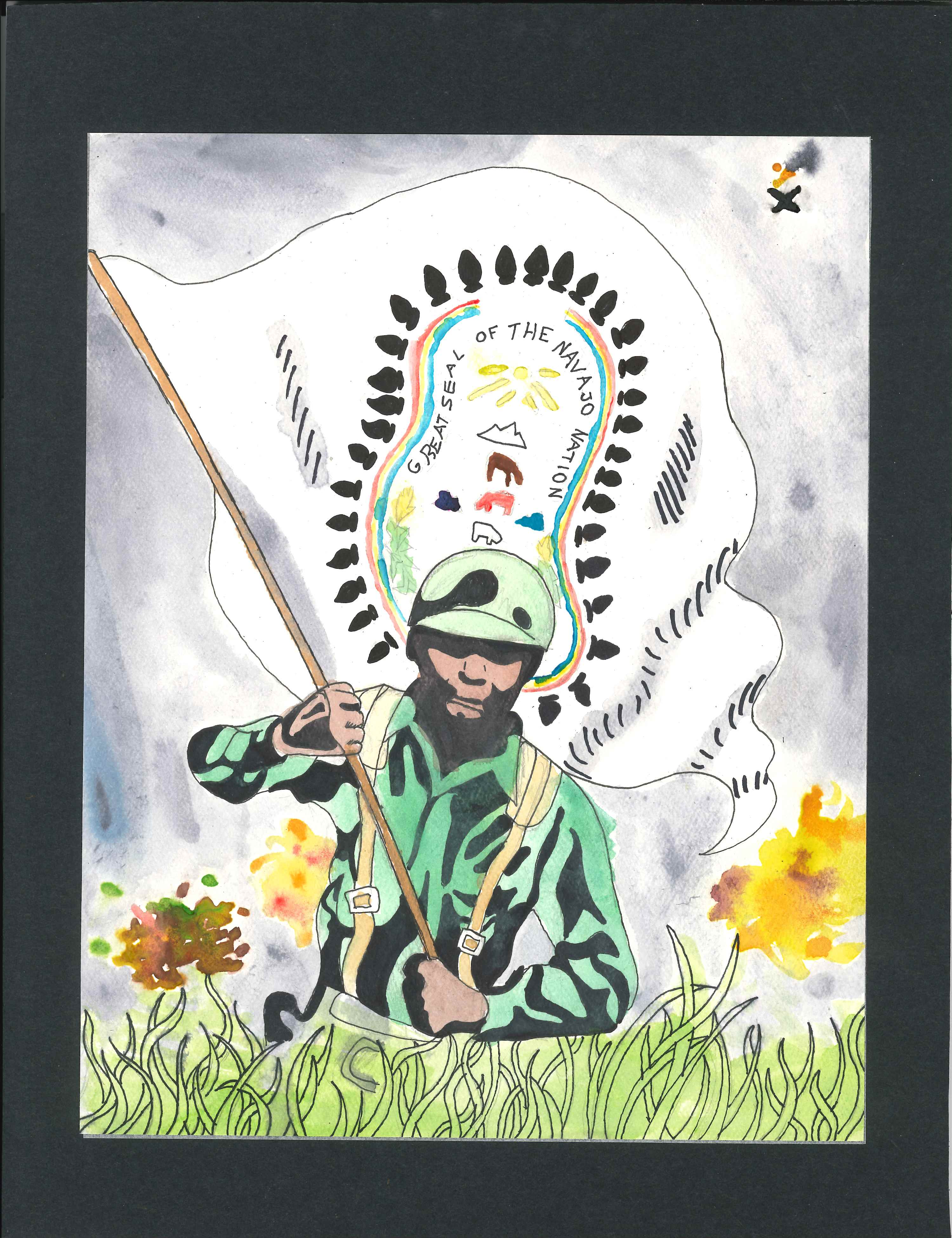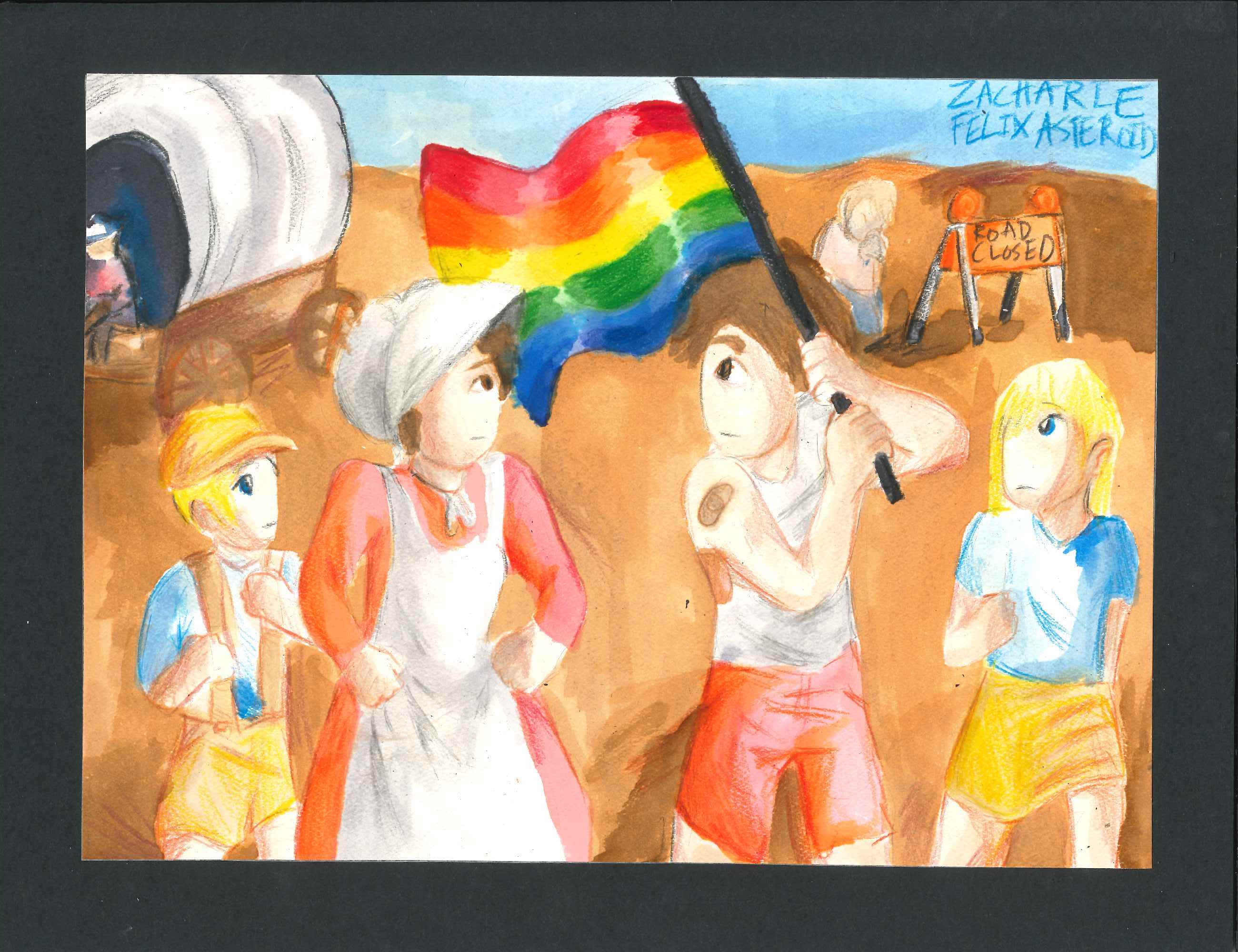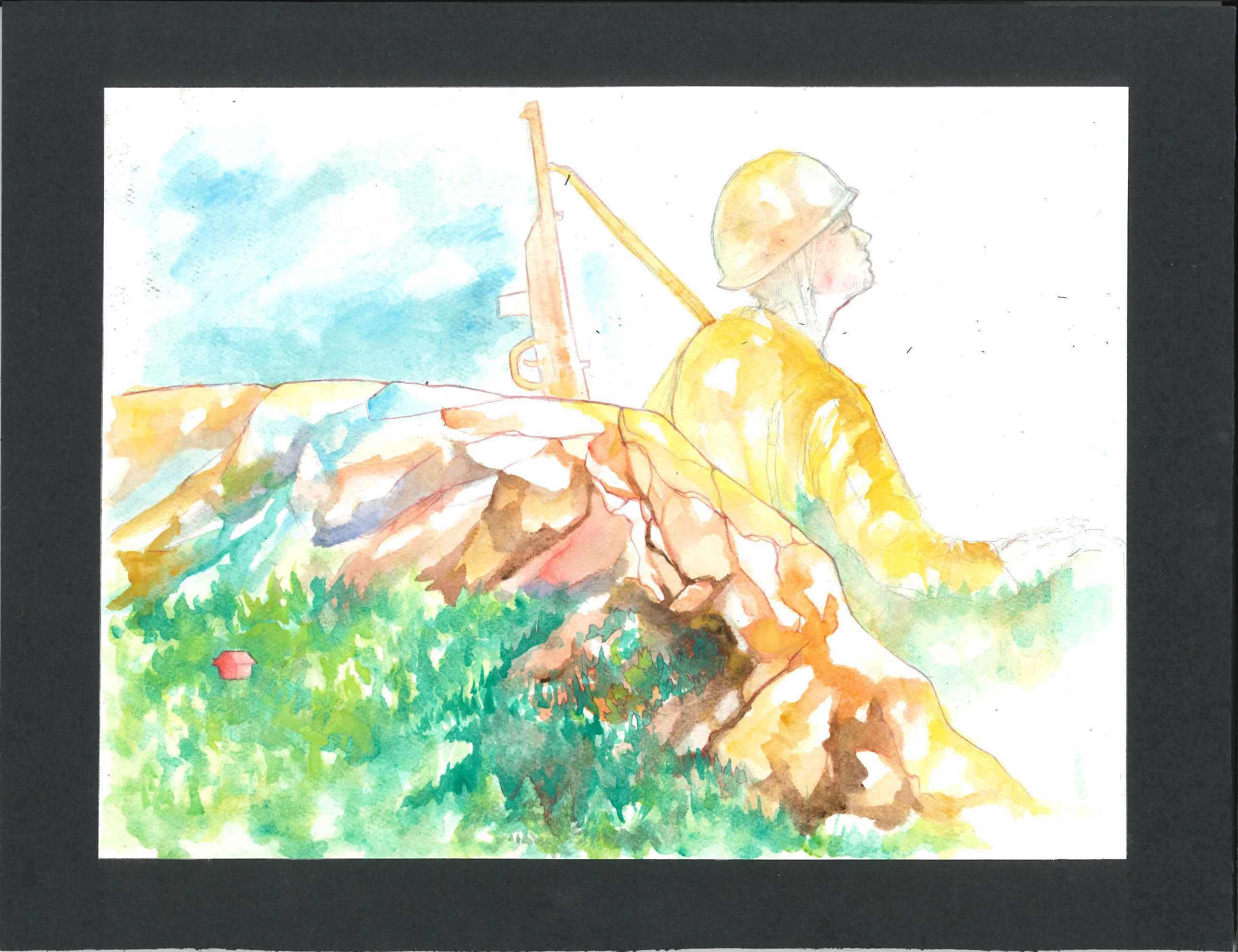Code Making and Perspective Taking
A new generation reflects on WWII, The Unbreakable Code by Sara Hoagland Hunter with illustrations by Julia Miner, and community in these watercolors from Tucson High Magnet School students under the direction of Andrea Burk.
I painted a plateau in northern Arizona, based on a photograph during the sunset, the sun going down and daylight transitioning into twilight. I used a variety of colors in watercolor and colored pencil. The picture is of a place that I remember, and my family will always remember the story behind the mountain, too. In this piece of art, I aimed to express my feelings and emotions connected to that place. I want the mountain to pop out, to be noticed by other people, so maybe they can imagine a setting important to their family history.
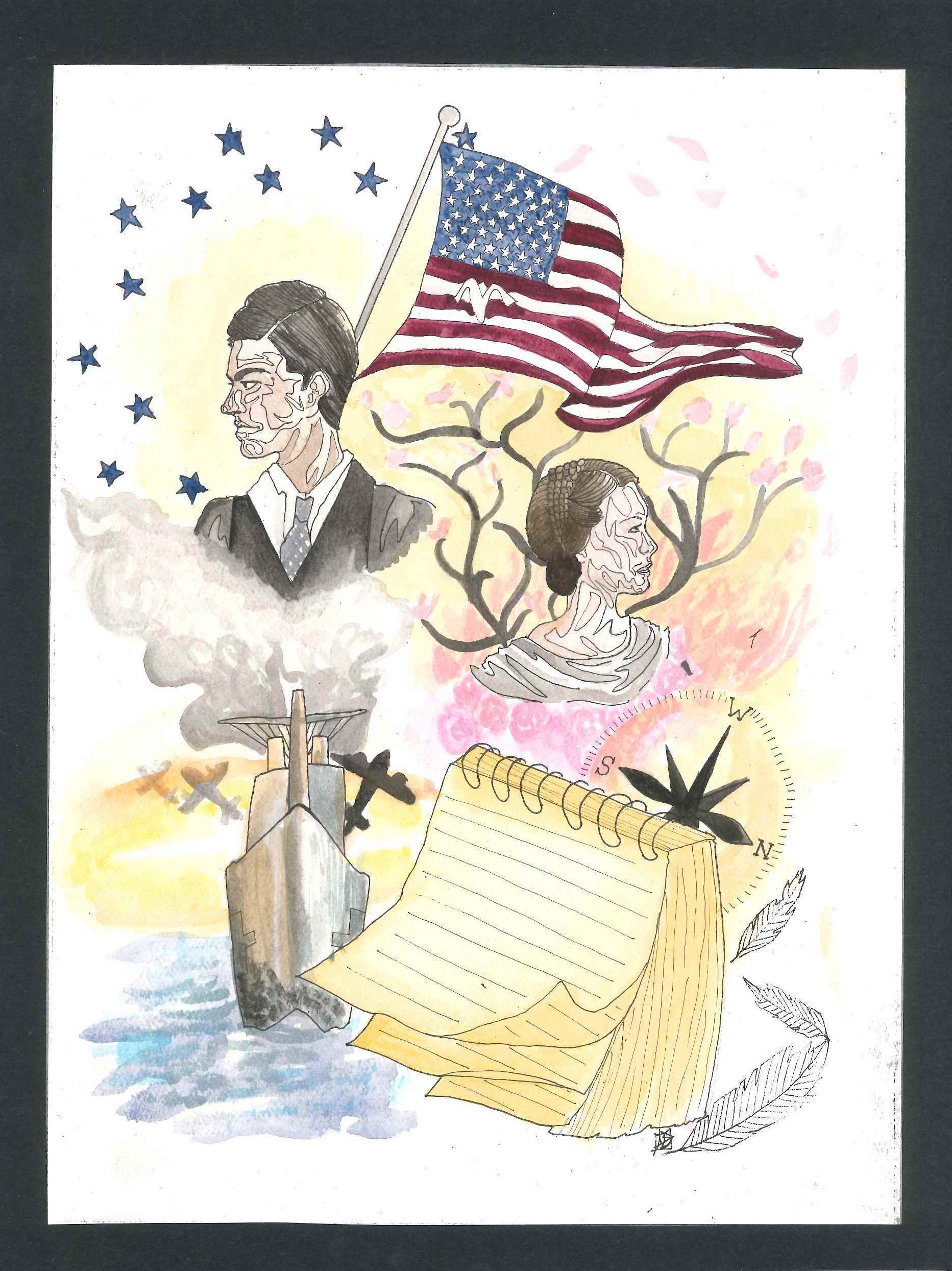
Amber Soland, Grade 11
My artwork features the image of a man and a woman in a flashback, a dream-like presentation of their reality during World War II. Arranged like a collage, drawn in ink, and painted with watercolor, this piece inspires memories of my grandmother.
The man and woman in the piece are my great grandparents, Donald Wabreham and Frederica Lamm. Donald Lamm was a foreign service officer in Japan at the start of World War II, and a prisoner of war. Torn between his love for Japan and his home in America, he and his wife were advocates of neutrality in the war. The image depicts my great grandfather from 1937, surrounded by American patriotism, and my grandmother facing a different direction, having been separated at the time, accompanied by her beloved cherry blossoms.
The piece of art also features the flash of the atomic bomb that my gradparents so despised; the exchange ship that saved my great grandfather; Donald Lamm’s yellow notepad in which he recorded his life; a neutral compass representing the loss of moral direction; and feathers, which inspire memories of my great grandfather’s passion for birdwatching.
My goal was to create a postcard or Christmas card for my grandmother, giving her physical images of her history and her late parents. This piece makes me feel proud, because my grandmother understands the inspiration and loves how I depicted her family.
My artwork is a landscape of my niño’s ranch. I was inspired to draw my niño’s ranch because we used to go and hang out there for a long time, and we used to ride my quad there. Through this artwork, I was able to focus on my memories of the time we spent there.
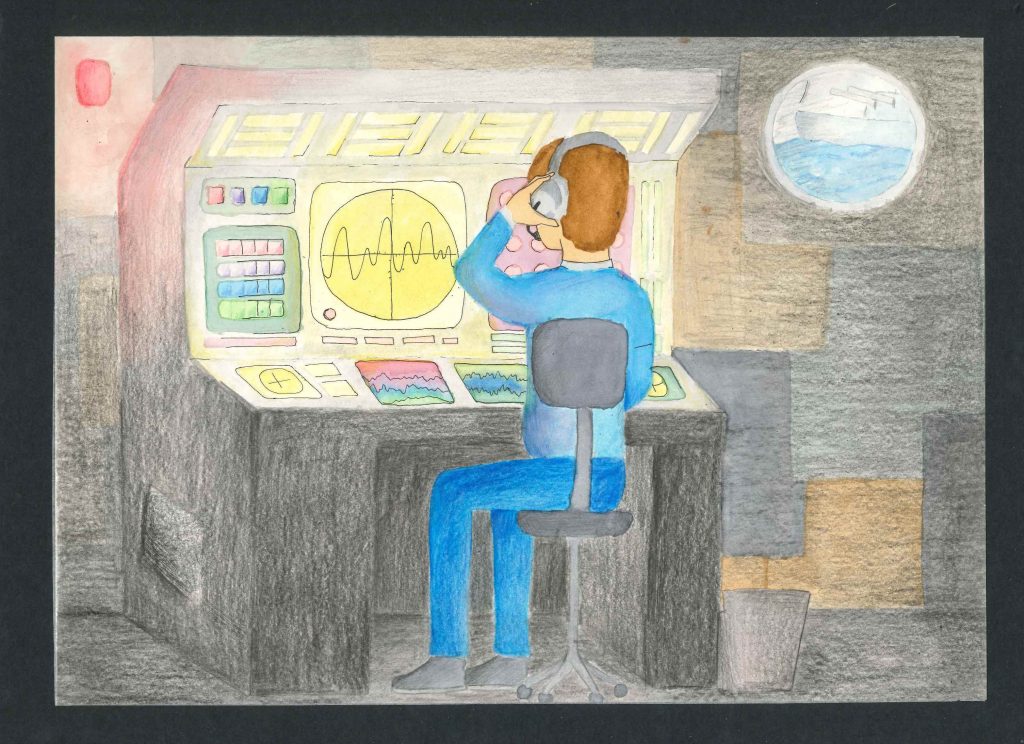
Grace Kimble, Grade 11
After reading The Unbreakable Code, I decided to create a piece that depicted my ties to the military through family. In my piece, I used a combination of watercolor paints, colored pencils and pen to create the image of a man at a control panel. The inspiration for my piece is my grandpa. He was in the U.S. Navy during World War II, and acted as a sonar man on a destroyer ship. In this piece, I worked toward improving my skills with mixed media to construct a theme for a specific audience.
My artwork represents the standard of family wisdom across generations. I used watercolor with some colored pencil, and the figures are outlined with pen. I was inspired to create this artwork because of the respect I have for my own culture and for my family and past generations. I respect how they moved to new places from their original home, and their “new place” has become my true home.
In my artwork, I depicted a boy getting his hair cut, with a sunset and mountains behind him. I used watercolor and colored pencil, after sketching with a pencil at first. The Unbreakable Code, which we read in class, inspired my artwork. The book expresses the oppression the Navajo people had to deal with. I made the subject in the painting have an expression of giving up.
I created this work using watercolor and colored pencil. This was the first time I used watercolors, and I used a wet-on-wet technique. My inspiration comes from my hometown of Tucson. I have lived in Tucson my whole life, so the landscape has become a part of me.
My artwork depicts a man in a war-torn city. The artwork is in a simplistic style. I did this by creating basic shapes using watercolor and adding detail with a black pen. My artwork shows that everyone is affected by war, not just those in combat. With this piece, I wanted to use a simplistic style to make the idea not clear right away, and to leave the viewer to truly think about the piece.
Native American culture involves family. Family is important, especially grandmothers, for they are older and wise. My work features an old grandmother sitting in front of her pots, portrayed as a bunny. This piece includes watercolor and colored pencil. I wanted people to feel happy when they see it. Family makes people happy, and bunnies are cute, so how could one not be happy?
My artwork is a desert landscape that has mountains, water, animals, insects, and a big, bright sun on the mountains. It also features letters of the Navajo code. The most obvious image on my artwork is the sun, reflecting into the water, and all the letters on the mountains. My artwork is made from watercolors, and I used a brush to create this work. I live in a really hot desert, and the sun is out almost everyday, and that’s why I chose it as the main feature.
This is a watercolor piece with ink outlining. It is a split composition, with the moon to the right and the sun to the left. In the center is a young woman in traditional Yaqui attire, and the essence of the Hummingbird encompasses her. My work was inspired by the traditional beliefs of my culture. Ever since I was young, my grandmother would share all these wonderful stories about the spirits and the world they live in.
The three key figures of this piece are: Achai Taa’a (Father Sun), Semalulukut (Hummingbird), and Maala Mecha (Mother Moon). In my culture, the hummingbird does not only symbolize beauty but it is also a representation of the Spirit Realm known as Sewa Ania (Flower World). With this piece I hope to present a part of my culture to those that don’t know about it. And as Sara Hoagland Hunter did in The Unbreakable Code, I wish to preserve the knowledge my grandmother had passed down to me. As in all of my work, I strive to honor my culture, my beliefs, and my grandmother.
My work depicts a woman looking off into the sunset, asking for her husband to come back. The piece is meant to pay homage to the Navajo Code Talkers during World War II. This piece was created using watercolors. I used various wet-on-wet and wet-on-dry techniques. I also used pen and colored pencil. This work is meant to pull at the heartstrings of anyone who views it. I want those who see it to ache just like the wife in the painting does. Overall, this was an extremely enjoyable piece to create.
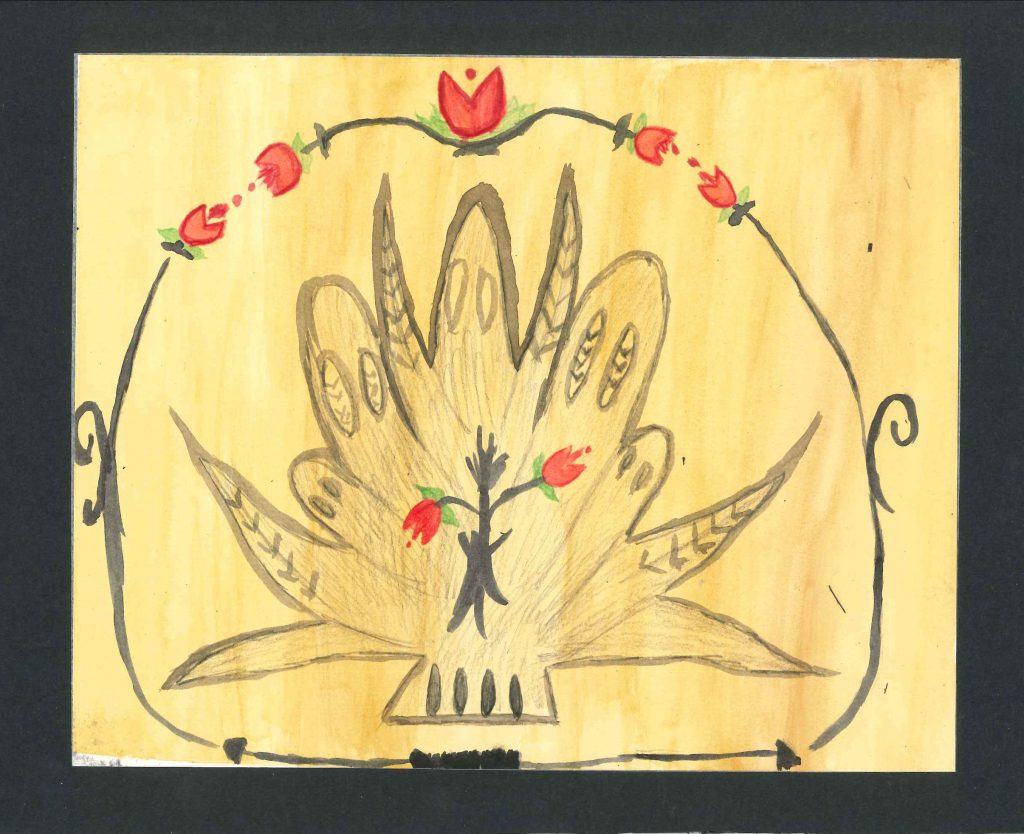
Sidney Metoyer, Grade 11
My artwork is the symbol of the Chippewa Indian Tribe. I connect with this work because on my dad’s side of our family, we are Chippewa Indian. I put my own culture into this piece. To create this artwork, I used mostly water colors. After painting, I went back with colored pencils to add more detail. My inspiration was from the book that we read in class called The Unbreakable Code.
In this piece, I utilized the concept of family and hometowns as well as some symbols that connect to the code talkers. Culture and cultural ideas are different for everyone, which makes it unique. Somewhat hidden are the symbols for the letters that The Unbreakable Code contained. These symbols spell out “culture”. For example, the C in culture is recognized as a cactus. This symbolizes that everything around you is what forms your culture.
This artwork was made to look like traditional propaganda, with very heavy shading and vibrant subject matter. But most propaganda only shows white men and no minorities, so I decided it would be a twist to depict a minority. The mediums used are felt-tip marker for shading, because it gives it a very serious tone, and watercolor. In my piece I wanted to give a somber tone, but keep the classic propaganda look. Most propaganda depicted what was a “glorious battle,” where you rush in and defeat the enemy. But the reality of war isn’t glorious, it’s really nasty, and there’s no real feeling of victory.
My work is done with watercolor and colored pencil. It depicts pioneers and people in a pride parade looking at each other through different purposes and periods of time. My ancestors came to America to join the LDS church, and my parents left with just as much passion. The concept I’m trying to convey is my family, the Mormon side, and part of what we’ve become afterwards. It’s simplified, but my message is this: We’re both pioneers of our own kind, and both struggling to cross the plains for our own noble causes.
I chose to draw a representation of the sacrifice many soldiers made while defending their cause, whether that was fighting for their home or reflecting upon it. I imagine home would seem like total bliss compared to the chaos of war in a soldier’s final hours on duty; what did he think about at that moment? His home! His serene, comfortable and very distant home.
Utilizing watercolor with Prisma pencil, I tried to recreate a mountainous/forested landscape, with a little red house representing the home the soldier left. More than anything, I wanted to convey my admiration for those who gave their lives for the peaceful futures of others.
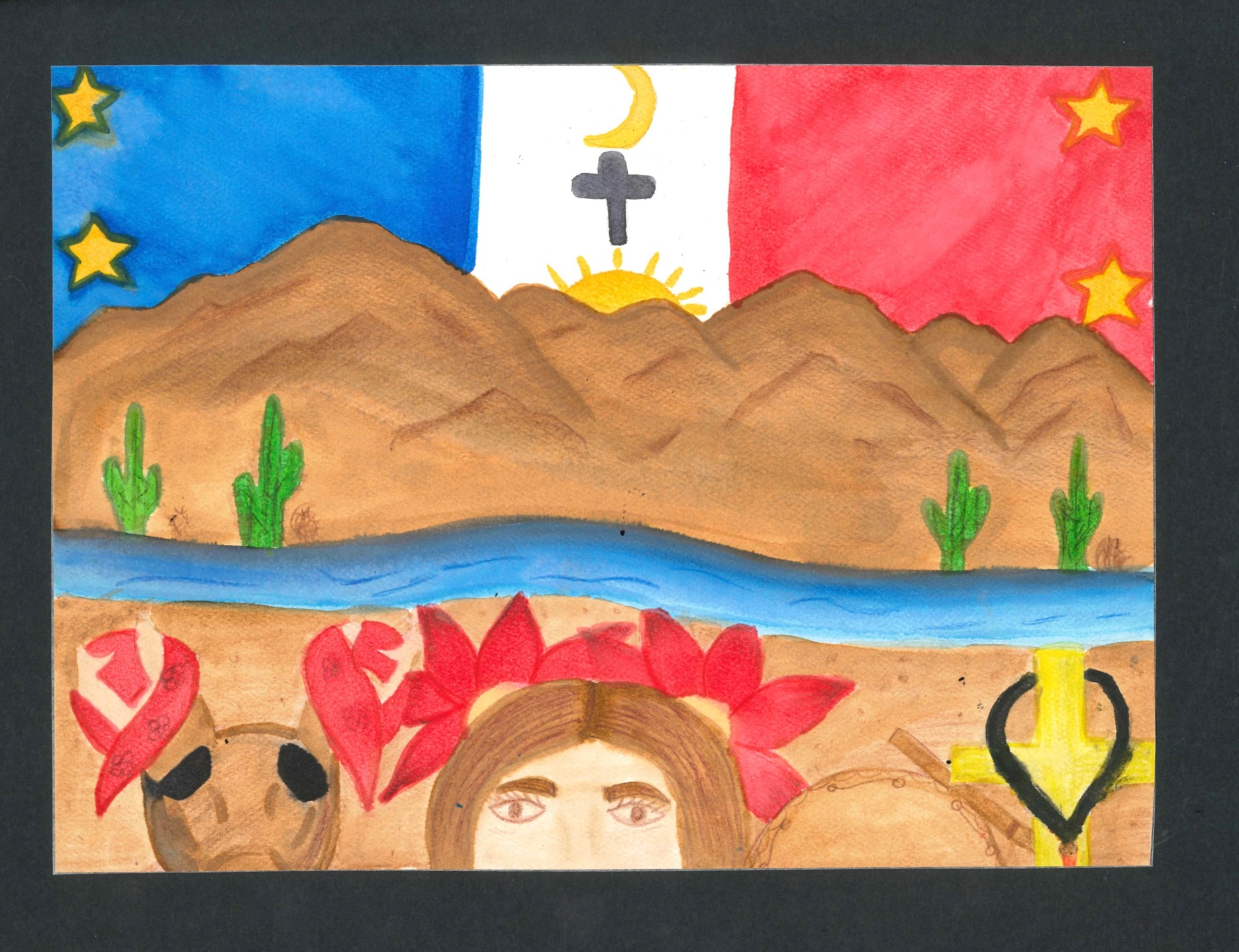
“Lios Em Chaniavu” by Adriana Esquivias, Grade 12
After reading The Unbreakable Code, I was inspired to create a piece of artwork that would symbolize my culture by having objects that have a huge meaning in the Yaqui culture. My artwork is called “Lios em Chaniavu” because it’s a well-known greeting in my culture and this artwork is an insight to who I am.
To create this artwork, I used watercolor for a general color of the objects. I also used colored pencils to add detail to them. The objects shown are a flag that was created by my ancestors, a deer dancer that is used in many cultural ceremonies, a cross that represents my religion, a drum to symbolize my culture’s instruments, flowers to show a craft, desert to show our respect for our land, and me, because my culture is what makes me who I am.
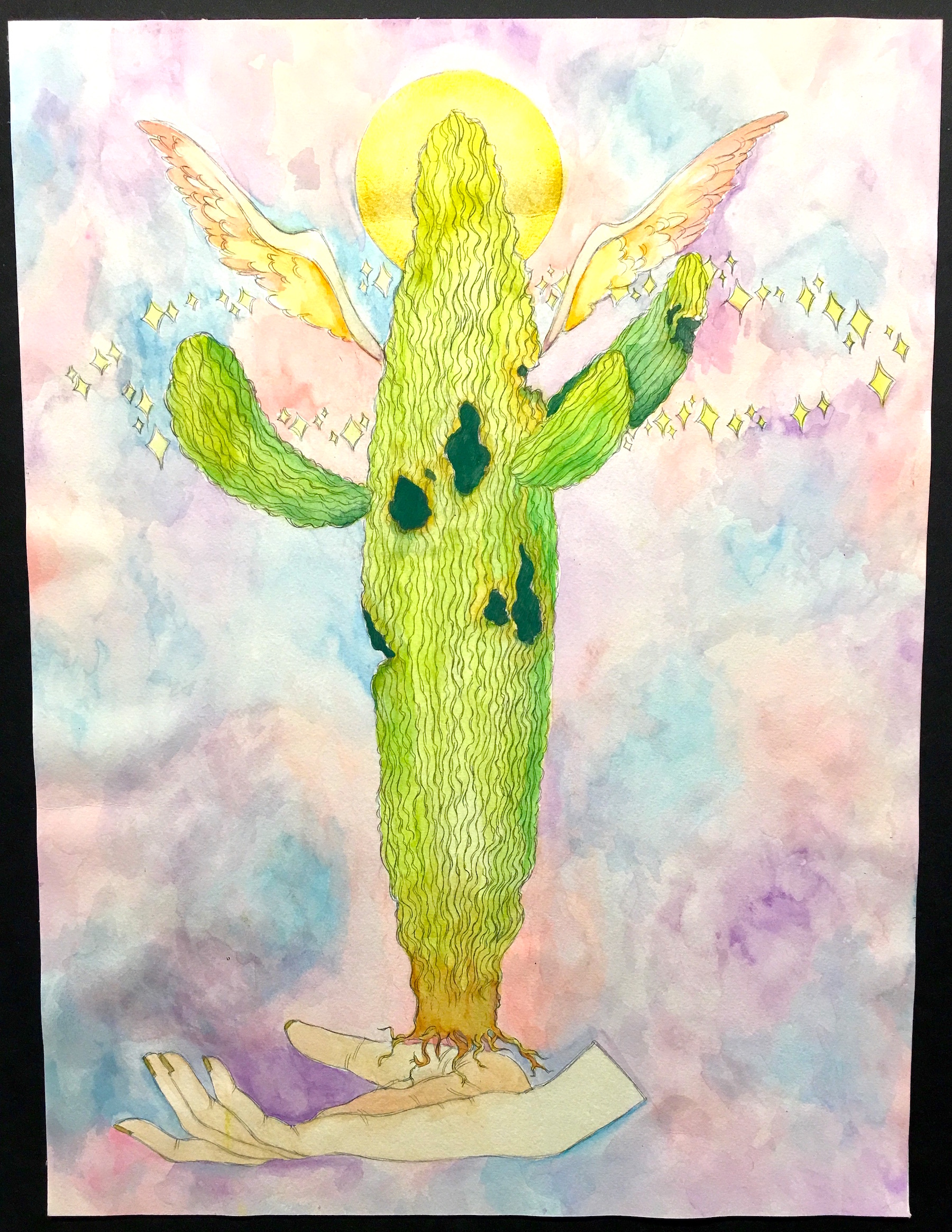
“El Circo de Nopal” by Sunny Michel, Grade 12
Like a code, my art piece is made entirely through symbolism. It all represents my childhood memories. The galaxy represents the nights I spent with my telescope in the back yard; the sky was once clear and visible. The wings and halo represent Catholicism; God plays a role in everyday Mexican life. The hand holding the cactus is my mother’s; it represents the way that she “carries” me through mental illness. My art was made using metallic watercolor and acrylic paint. The big idea behind my art is the, “cactus circus.” It basically means my life is crazy. I want my art to be provocative.

